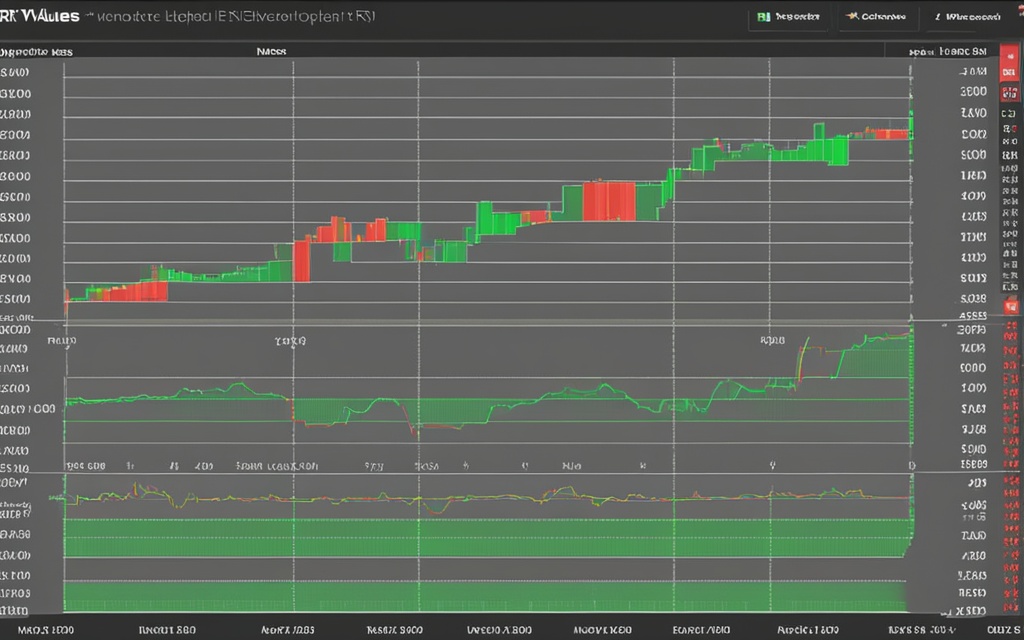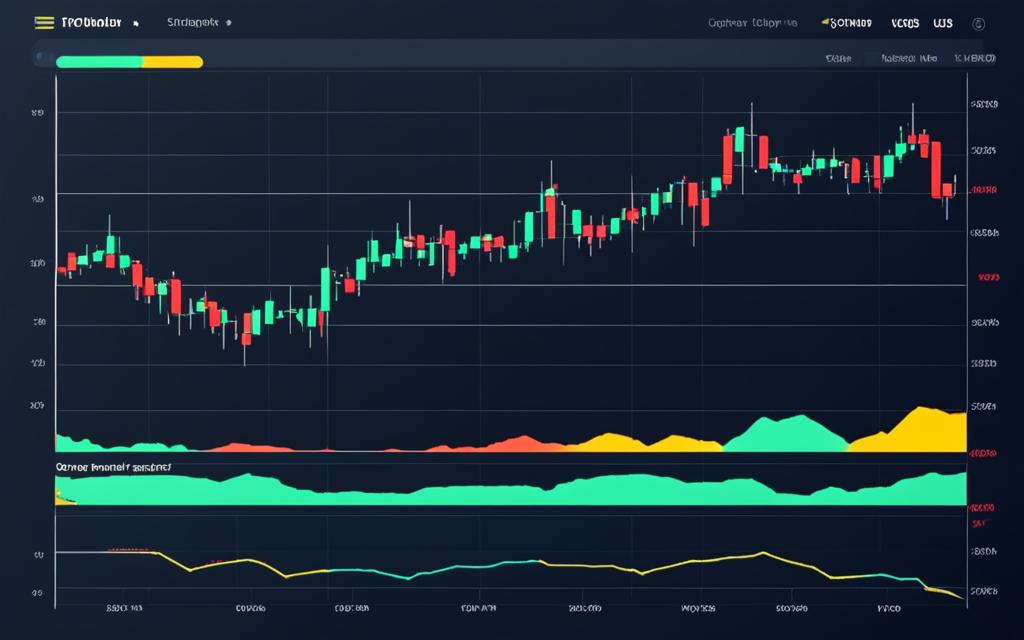Table of Contents
The Relative Strength Index (RSI) is key for understanding market momentum in cryptocurrency trading. It looks at short-term price moves. This helps traders know when to buy or sell, spot trends, and increase earnings.
It rates market momentum from 0 to 100. Scores under 30 show prices are low and might rise soon1. Scores above 70 mean prices are high and could drop1. But sometimes, levels of 20 and 80 work better, depending on the crypto and market1.
In a bull market, traders see RSI below 40 as a sign to buy and above 90 as a sell chance1. But in a bear market, under 10 means it’s good to buy, and over 60 shows selling might be wise1. These marks offer useful info for making timely trading calls.
Cryptocurrency traders use RSI in many ways. For example, swing traders watch it to time their trades well1. Also, it helps to find points on the chart where the price might change direction, aiding in decision-making1.
Traders keep an eye on RSI divergence, either bullish or bearish. The bullish type happens when prices rise but RSI falls, a sign to consider buying1. Bearish divergence is the opposite, suggesting it might be time to sell1.
RSI’s calculation uses average price gains and losses over around 14 days1. This gives insight into market direction and trends.
For better strategies, traders should mix the RSI with other analytical tools and indicators. This thorough method offers a clearer view of market conditions and boosts the strategy’s success2.
Key Takeaways:
- The RSI is a great metric for understanding short-term trends in cryptocurrency trading.
- It shows when prices might be too high (overbought) or too low (oversold).
- Divergence in RSI can hint at good times to buy or sell.
- Using the RSI with other tools can make trading strategies better.
- Knowing the basics of trading and analysis is crucial for trading cryptos well.
For more on the RSI indicator, check out these resources:
Cointree’s Technician’s Take,
Bitsgap’s Blog,
UEEX’s Blog.
How to Read the RSI
The Relative Strength Index (RSI) helps in the crypto market. It shows recent price movements and potential trading chances. Traders need to learn how to use this tool for better decisions.
The RSI is a percentage that goes from 0 to 100. Two lines show overbought and oversold markets. A RSI over 70 means the crypto is overbought and might drop. But, if the RSI is under 30, it’s oversold and could go up3.
Most traders look at the RSI chart under the price over several weeks. This gives them the best information. Short times can be good for quick trades, but looking longer helps understand price changes better.
The Standard Interpretations of RSI Levels
If the RSI is over 70, the asset might be overbought. It could drop soon. When it’s below 30, it’s seen as oversold. This could be a good time to buy4. These levels guide traders in spotting market changes.
It’s key to notice that the RSI’s high point varies in downtrends. Instead of 70, it often hits about 50. RSI levels may form a range during trends. For example, in an uptrend, it often stays above 30 and can go up to 70. In downtrends, it’s the opposite4.
Understanding RSI Divergence
RSI divergence means the price moves differently from the RSI. This can signal a momentum change. A bullish divergence shows potential for rising prices. A bearish one hints at prices going down. Traders use this to predict market changes and adjust their strategies4.
A positive RSI reversal is when the RSI hits a new low but the price doesn’t. This is seen as a bullish sign. A negative reversal is the opposite, indicating prices might fall. These patterns give traders clues about market trends4.
Combining RSI with Other Technical Tools
Using the RSI along with other tools like moving averages can be powerful. It helps confirm trade signals and weed out false alarms. By doing this, traders make decisions based on stronger evidence3.
Setting the RSI right for your trading style and timeframe can make a big difference. For short-term trading, use a low setting. For long-term, use a high setting. This customisation improves the signal’s accuracy, important in the lively crypto market5.
Knowing how to use the RSI well is important for any crypto trader. It helps spot good trading times and understand market trends. With the right analysis and using other tools, traders can navigate the dynamic market effectively.
Identifying Overbought and Oversold Market Conditions
When trading in financial markets, knowing about overbought and oversold conditions is key. These show possible changes in market trends. They help traders find the best times to buy and sell. The Relative Strength Index (RSI) and the Stochastic Oscillator are two tools for this job. Let’s look at how they work.
The Relative Strength Index (RSI)
The RSI tells us how fast prices are changing. It gives a number from 0 to 100. If it’s over 70, it shows prices might fall soon. If it’s under 30, it means prices could go up.
The RSI works out wins and losses over time. Typically, it looks at the last 14 trading days. Remember, what’s overbought or oversold can change for different markets6.
The Stochastic Oscillator
The Stochastic Oscillator helps with overbought and oversold too. It looks at current prices and past prices over 14 days. A value above 80 can mean prices might drop soon. While under 20 could mean they’re likely to go up.
But, these tools aren’t always right on their own. Traders often use more than one signal to decide when to buy or sell. They might also watch trends and moving averages. This can make their decisions more solid.
Stocks or markets can stay overbought or oversold for a long time. This means they might not turn around when expected. So, it’s important to be patient and use several tools for a complete picture7.
For different market types, the RSI might be checked at different levels. In markets that do well (bull markets), a high RSI like 80 may signal prices will soon fall. In bad markets (bear markets), a low RSI like 20 might show prices are low but could climb. Adjusting RSI levels to the market can make decisions sharper6.
Undervalued and Overvalued Stocks
The RSI also points out cheap and expensive stocks. If a stock’s RSI is 30 or lower, it might be a good buy. A Stochastic Oscillator under 20 might mean the same. But if the stock is popular and its price is high, it could be time to sell7.
So, knowing about overbought and oversold zones is crucial for traders. Using the RSI and Stochastic Oscillator can help spot good times to trade. But, remember, they’re best used with other tools. This way, traders can make the most of market movements.
| Key Points |
|---|
| The RSI indicates overbought conditions when approaching 80 and oversold conditions when falling below 307. |
| The Stochastic Oscillator compares the current price to its range over a specific period to determine overbought (above 80) and oversold (under 20) levels7. |
| RSI levels of 30 and 70 may not always be the best levels to use for every cryptocurrency. Different levels, such as 20 and 80, may be more appropriate depending on the specific cryptocurrency and market conditions7. |
| Traders may use different RSI levels for bear and bull markets, with lower levels for bear markets and higher levels for bull markets7. |
Using the RSI in Crypto Trading Strategies
The Relative Strength Index (RSI) is a key tool for trading in cryptocurrencies. It helps traders make better decisions and increases their chances of success in the crypto market’s ups and downs.
It’s great for knowing when to step in or out of a trade. Traders watch for the RSI to go above 708 for selling signs. When it drops below 308, it could be time to buy because the market might be oversold.
Swing trading and RSI work well together too. A common tactic is to buy when the RSI is below 308 and sell at 708. Traders use this to profit from the market’s short-term movements within a certain timeframe.
Besides, the RSI also shows where the market might change next. Watching how the RSI moves around 50 helps traders guess where the market might “break out” or “break down”.
The RSI can also spot key moments for trades. For instance, it can signal a good time to buy when the RSI is rising against a falling price.
But, traders shouldn’t rely on RSI alone. It’s best to check its signals with price trends and other market info before deciding to trade.
Wrapping it up, the RSI is a handy tool for crypto trading. It helps traders know when to buy, sell, or wait. Yet, using it with other indicators and considering the market’s full picture is essential for smart trading.
Calculating the RSI
The Relative Strength Index (RSI) is vital for crypto traders. It gives key insights into market momentum and asset conditions. It helps validate trends, mark trend reversals, and identify overbought and oversold times. Understanding the RSI’s calculation is crucial for its effective use9.
RSI is figured out by looking at the average gain and loss over a set time. The formula to calculate RSI is quite simple:
RSI = 100 – [100 / (1 + (Average loss / Average gain))]9
This formula uses past average gain and loss, along with current data. It combines the past and current gains and losses to get the RSI number. The calculation considers various factors, including a 13 multiplier9.
While traders can calculate this by hand, most platforms and charts (like TradingView) have RSI included. This means traders can get RSI for different time frames and assets without extra work9.
RSI’s values are shown as a line that moves between 0 and 100. A value over 70 means the asset might be overbought, preparing for a price drop. Below 30 suggests oversold, potentially leading to a price rise10.
Remember, RSI is best used with other indicators for smarter trading. It offers great clues but shouldn’t be the only factor driving decisions. Traders need a mix of insights and strategies, not just indicators9.
In summary, using RSI helps traders understand market momentum and find good entry or exit points. Combining RSI with other tools makes trading decisions sharper. This can lead to increased profits and better risk management910.

The Importance of Combining Indicators
In cryptocurrency trading, technical analysis is key to making smart choices. The Relative Strength Index (RSI) is important but it’s best used with other indicators. This combo gives you a full picture, which can boost your trading success.
Including several indicators in your study can help you deal with market ups and downs. It makes your forecasts more accurate. The RSI works well with the MACD and Bollinger bands, providing extra clues and market insights.
When RSI shows extreme highs or lows, say above 70 or below 30, adding more indicators can confirm these signs. For example, the MACD can back up RSI’s signals. This makes your decisions more robust. Using the MACD with the RSI can sharpen your trading moves.
Using moving average crossovers with the RSI can also make your analysis stronger. For example, if a short-term moving average crosses a long-term one, it can confirm RSI readings and hint at trend changes. This method helps you see the market from different angles.
Moreover, teaming up Bollinger bands with the RSI adds another layer of knowledge. Bollinger bands spot market volatility and drastic price changes. By combining them with the RSI, you get a deeper understanding of market conditions. This mix can fine-tune your trading strategies.
Advanced methods, like Livermore’s pivotal point system, can flag bullish turning points. For example, when the RSI dips below 30, it could show the potential for a bullish comeback. This aligns with Livermore’s strategy.
Using multiple indicators helps traders gain useful insights. Combining the RSI, MACD, Bollinger bands, and more forms a strong analysis arsenal. This toolbox is great for understanding the cryptocurrency market better and dealing with its changes.
Ending, while the RSI is crucial, using other tools like the MACD, Bollinger bands, and Livermore’s methods boosts your technical analysis. By mixing these, traders can access more data, which is vital for better strategies and handling market twists.
Reference:11
| Indicator | Benefits |
|---|---|
| Moving Average Convergence Divergence (MACD) | Confirms RSI indications of overbought or oversold conditions |
| Bollinger bands | Provides insights into volatility and trend reversals |
| Moving Average Crossovers | Identifies potential trend changes in conjunction with RSI |
| Livermore’s Pivotal Points | Utilizes RSI below 30 as a bullish reversal point |
What is an RSI Indicator in Crypto Trading?
The Relative Strength Index (RSI) is a key tool in cryptocurrency trading. It shows if an asset’s price is too high or too low. This can help predict when the price might change. It goes from 0 to 100 and is trusted by many traders.
Created by Welles Wilder 40 years ago12, the RSI measures how quickly an asset’s price is changing. It looks at how much the price goes up compared to how much it goes down. This tells us if the asset is over or under-valued.
If the RSI is over 70, the asset might be too expensive and its price could go down soon13. If it’s under 30, the asset might be cheap and so its price could increase13. These points are useful for deciding when to buy or sell.
Traders also use the RSI with other tools to make sure of their decisions. Looking at different indicators together helps them be more sure about the market’s direction13. But remember, the RSI alone can’t predict everything in the market13.
The RSI can do more than just show if something’s over or under-priced. It also helps spot when the price and RSI don’t match up. These differences often hint at future price changes. For example, if prices go up but the RSI goes down, this could signal a drop in price soon.
When the RSI says something’s too cheap, it might be a good time to buy13. And when it’s too expensive, selling might be a good idea13. Traders try to use this information to make money.
Knowing how to use the RSI well is an important part of crypto trading. But no one tool can predict everything. It’s best to look at the RSI along with other tools. This gives traders a fuller picture of the market and helps them make better decisions14.
| RSI Reading | Market Condition | Historical Price Movements |
|---|---|---|
| Above 70 | Overbought | Historically led to price declines ranging between 50% and 72% |
| Below 30 | Oversold | Historically resulted in price rallies between 76% and 332% |
Mixing the RSI with other tools can lead to a good trading strategy. By watching the RSI and considering the market, decisions can be smarter. Remember, using many tools together is the best way to understand the market14.
How to Use the RSI Indicator in Crypto Trading
The Relative Strength Index (RSI) helps traders improve their cryptocurrency strategies. It gives insights into market momentum and signals when to buy or sell. It’s also great for spotting when prices are too high or too low.
Understanding overbought and oversold levels is key with RSI. It measures between 0 and 100, with overbought (too high) at 70 and oversold (too low) at 3015. If RSI is over 70, it might mean prices will fall soon. If under 30, it could be a good time to buy15.
The RSI can help with deciding when to buy or sell. For example, buying can be good if RSI is under 30 and then goes back up15. Selling might be smart if RSI is over 70 and then drops15. These techniques work best when the market is following clear trends, buying low and selling high.
Traders often pair the RSI with other tools to get a thorough market view. They might look at RSI trends alongside price trends for good entry points16. Using moving averages with RSI also gives a deeper market understanding15.
Remember, the RSI is just one tool. To be more accurate, combine it with other indicators like moving averages16. This gives a better picture of what the market is doing, helping you make smarter trading choices16.
Here’s a table to help you interpret RSI values:
| RSI Level | Interpretation |
| ————- |———————–|
| Above 70 | Overbought, sell signal|
| Below 30 | Oversold, buy signal |
| Between 30-70 | Neutral |
Using the RSI in crypto trading can make your decisions sharper and more informed. By knowing when to buy or sell and using the RSI with other tools, like moving averages, you can boost your trading success. Intelligence in combining indicators with an eye on market trends lays a path to profitable trading in the risky crypto market.
RSI Trading Strategies
When you trade cryptocurrencies, good RSI strategies can boost your success. The Relative Strength Index (RSI) helps with this17. It’s important to know strategies like overbought/oversold signs and bullish/bearish divergence. Knowing these can help you decide better in the market.
Using Overbought and Oversold Signals
One strategy looks at overbought and oversold signals for trade points17. The RSI goes from 0 to 100. Above 70 is overbought, below 30 is oversold18. You might sell over 70 and buy under 30 to catch market turns.
Utilizing Bullish and Bearish Divergence
Another way is spotting bullish and bearish divergence18. Bullish is when an asset’s price dips but RSI rises, hinting at a buy chance18. Bearish is the opposite, signalling a possible sell. Traders use these signs to time their trades right.
Keep in mind, RSI strategies work differently based on time frames and markets. For swings, using RSI over 20 can catch trends17. Intraday prefers a short RSI, like 9 or 4, for faster insights17. Day traders might look at crossovers with RSI 4 and 9 for quick charts17. Cryptocurrency markets are great for RSI due to their quick changes17.
When using RSI, tweaking the settings might help. Changing the period to 8 and the overbought/oversold to 80/20 can boost the strategy17. By matching RSI with price movements, trades can align better. RSI helps traders spot market changes fast, leading to smarter choices17.
| RSI Trading Strategies | Statistical Data |
|---|---|
| Swing Trading RSI Period | 20 |
| Intraday Trading RSI Period | 9 or 4 |
| Day Trading RSI Period | 4 and 9 |
| Ranges for Overbought and Oversold | 70 and 30 |
| Optimized RSI Settings | Period 8, Threshold Lines 80 and 20 |
Adding RSI strategies to your cryptocurrency trading can really help. Using overbought/oversold and divergence signals, you can trade smarter. This might boost your profits17.
The Importance of a Good Crypto Trading Terminal
For successful cryptocurrency trading, a reliable, efficient crypto trading terminal is essential. Cryptorobotics is an example of a top-notch terminal. It offers tools and features that can really boost a trader’s success and profit.
A key benefit of using such a terminal is the access to important technical indicators. For example, the RSI, which stands for Relative Strength Index, is a trusted tool. It’s great for understanding market trends and making smart trading choices. These indicators are found on most trading platforms19.
Cryptorobotics lets traders use multiple exchanges at once through APIs20. This feature allows traders to spread their investments, taking advantage of diverse opportunities.
This terminal supports many order types, like limit and market orders. It also has essential risk management tools, such as stop-loss orders, to help traders avoid big losses. With these features, traders can better protect and grow their money20.
Using alerts on Cryptorobotics helps traders keep up with the market20. They get notified about crucial market events. This way, they can act quickly on new opportunities.
What’s more, Cryptorobotics also offers automated trading through bots and algorithms20. This means trades can happen automatically, even if the trader isn’t watching the market. It’s a way to seize opportunities 24/7.
Security is paramount on a high-quality trading terminal like Cryptorobotics. It uses the latest in security tech to protect user data and accounts20.
Cryptorobotics has a variety of tools available for both manual and automated trading. And this all comes at a fair price. Traders can get advanced features without huge upfront costs, thanks to a sharing system20.
With Cryptorobotics, traders get round-the-clock market access. The terminal supports a variety of coins and has easy-to-use charts. This makes the trading process smoother and more profitable20.
The cost to use Cryptorobotics varies, from a free plan with limited features to affordable paid plans20. For instance, a package offering 10 signal channels and access to 14 exchanges costs $79.05 for one month20.
To sum up, a good crypto trading terminal is a must-have for any serious trader. It offers powerful tools, supports reliable trading, and enhances the trading experience. And Cryptorobotics stands out as a great choice for those wanting to step up their game in crypto trading.
Conclusion
The RSI indicator is important for cryptocurrency traders. It shows market trends and finds possible price changes. It’s great for markets with steady prices. This makes it a key part of trading well in the crypto market.
Using RSI, traders can spot signals when prices are too high or low. They look at changes in these signals too. This helps them decide when to trade, making them more money. Adding tools like Bollinger bands and MACD to RSI gives them a full view of the market. It helps them take fewer risks and have more wins.
Studies show that RSI is good at predicting price movements in many cryptocurrencies. This includes well-known ones like Bitcoin, Ethereum, and Dogecoin. So, using tools like RSI is wise for making smart trades.
To do well in trading, it’s key to look at the market closely. Use different tools and strategies with RSI. This way, traders can find the best chances to profit in the crypto market.
Trading smart means being disciplined and ready to change with the market. Keep learning and use tools like RSI to trade with confidence in the crypto world.
References:
21 Statistical data extracted from Link 1
22 Statistical data extracted from Link 3
FAQ
What is the RSI used for in cryptocurrency trading?
The RSI measures short-term momentum in the cryptocurrency market. It helps traders know the recent price moves’ strength and direction. This info can time their trades well.
How do you read the RSI?
The RSI shows as a percentage from 0 to 100, under the price on a graph. It has two lines on the chart. They show when a market is too overbought or oversold.
How can the RSI help in identifying overbought and oversold market conditions?
If the RSI is above 70, it means the market might be overbought. Prices might go down soon. An RSI below 30 shows markets that are possibly oversold. This could lead to higher prices.
How can the RSI be used in crypto trading strategies?
The RSI helps find the right time to start or leave a trade. For instance, wait for the RSI to reach over 70 before selling. Go for an entry with an RSI under 30. It’s good for swing trading and spotting key levels.
How is the RSI calculated?
It uses the average gain and loss over some time. The formula is: RSI = 100 – [100 / (1 + (Avg gain over n days that closed up / Avg loss over n days that closed down))].
Should the RSI be used in combination with other indicators?
Yes, it’s smart to use the RSI with other indicators. Doing this helps make better trading choices. Using more than one tool gives you a fuller view of the market.
What is the RSI indicator in crypto trading?
The RSI is a tool that shows if a market is too overbought or oversold. It runs from 0 to 100. Traders use this for hints of potential price changes.
How can the RSI indicator be used in crypto trading?
The RSI can signal when to trade by showing overbought (above 70) or oversold (under 30) states. It also helps track market momentum and trends.
What are some RSI trading strategies?
In RSI strategies, overbought and oversold are used to find entry and exit points. For example, selling over 70 and buying under 30. You can also look at price and RSI differences.
Why is a good crypto trading terminal important?
Good Crypto and others like it offer advanced tools, including the RSI. These are key for a reliable and lucrative crypto trading setup.








